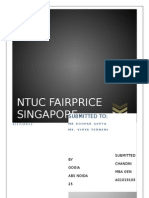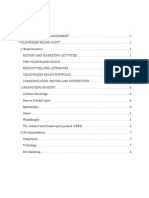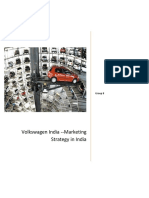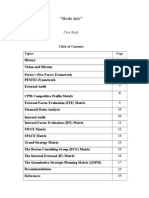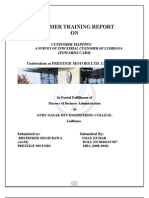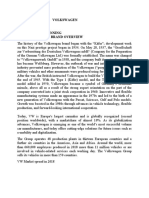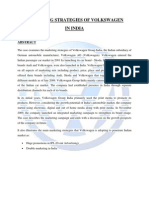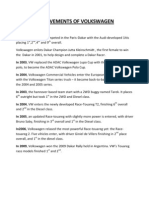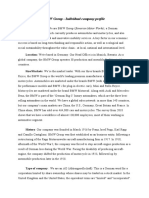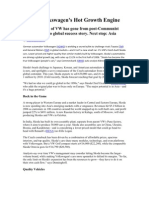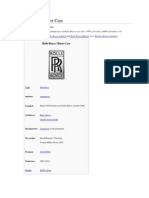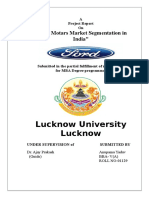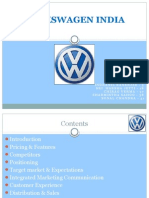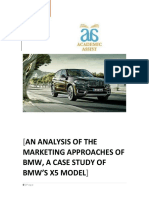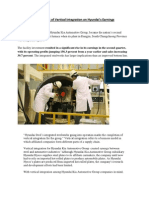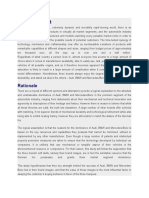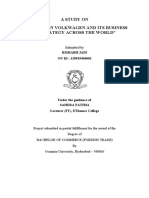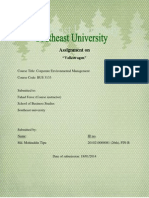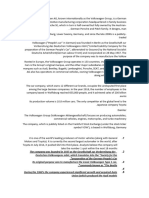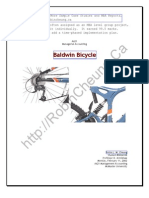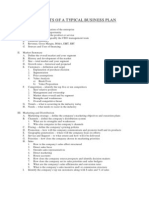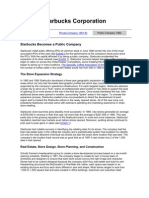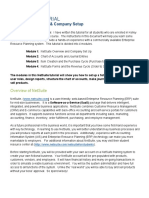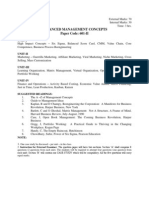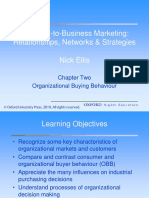Volkswagen - Ibm Final
Volkswagen - Ibm Final
Uploaded by
Anil LalvaniCopyright:
Available Formats
Volkswagen - Ibm Final
Volkswagen - Ibm Final
Uploaded by
Anil LalvaniOriginal Title
Copyright
Available Formats
Share this document
Did you find this document useful?
Is this content inappropriate?
Copyright:
Available Formats
Volkswagen - Ibm Final
Volkswagen - Ibm Final
Uploaded by
Anil LalvaniCopyright:
Available Formats
AN ASSIGNMENT
ON
INTERNATIONAL BUSINESS
MANAGEMENT
TOPIC:
VOLKSWAGEN
SUBMITTED BY:
Anil Lalvani (10057)
SUBMITTED TO: PROF. SUSHIL
CHAURASIA
TOLANI INSTITUTE OF MANAGEMENT
STUDIES
Tolani Institute Of Management Studies Page 1
TABLE OF CONTENT
SR. CONTENT PAGE
NO NO
1 COMPANY OVERVIEW 3
2 BUSINESS DESCRIPTION 7
3 STRATEGY OF INTERNATIONAL 16
BUSINESS
4 INTERNATIONAL MARKETING 22
5 INTERNATIONAL FINANCE 25
6 INTERNATIONAL HRM 32
7 SUPPLY CHAIN MANAGEMENT 36
(SCM) AND
GLOBAL MANUFACTURE
LOCATION
Tolani Institute Of Management Studies Page 2
COMPANY OVERVIEW
Volkswagen was originally founded in 1937 by the Nazi trade union,
the German Labour Front (Deutsche Arbeitsfront). Literally, the word
"Volkswagen" means "people's car." As a carmaker, they are under an
obligation to their customers and society to supply high-quality products
that are safe and environmentally compatible. The Volkswagen Group with
it’s headquarter in Wolfsburg is one of the world’s leading automobile
manufacturers and the largest car producer in Europe. In the early 1930s
German auto industry was still largely composed of luxury models, and the
average German rarely could afford anything more than a motorcycle.
The "Volkswagen Group" consists of some of the biggest names in the
Automobile Industry. The Group consists of eight brands: Volkswagen, Audi,
Bentley, Bugatti, Lamborghini, SEAT, Skoda and Volkswagen Commercial
Vehicles. Each brand has its own character and operates as an independent
entity on the market. The product range extends from low-consumption
small cars to luxury class vehicles. The Volkswagen Group's models are sold
in more than 150 countries. The Board of Management of Volkswagen AG
comprises five members. Each Board Member is responsible for one or more
functions within the Volkswagen Group. Prof. Dr. Martin Winterkorn is the
Chairman. The work of the Board of Management of Volkswagen AG is
supported by the boards of the brands and regions as well as by the other
group business units and holdings. The Supervisory Board is responsible for
monitoring the Management and approving important corporate decisions.
Moreover, it appoints the Members of the Board of Management. The
Supervisory Board of Volkswagen AG comprises 20 members and conforms
to the German Co-determination Act. Dr. Ferdinand K. Piëch is the Chairman
of the Supervisory Board of Volkswagen AG.
Tolani Institute Of Management Studies Page 3
➢ Group Values
• Customer Nearness
• Top Performance
• Added Value
• Renewability
• Respect
• Responsibility
• Sustainability
Tolani Institute Of Management Studies Page 4
➢ A BRIEF JOURNEY THROUGH A LONG HISTORY
When in 1937 the company known as "Gesellschaft zur Vorbereitung
des Deutschen Volkswagens mbH" was founded, no one could have guessed
that it would one day be Europe's largest carmaker. The history of the
company - with all its trials and tribulations - is first and foremost a story of
impressive success. It is this very company that today company come to
know as “VOLKSWAGEN”.
1937-1945
On May 28th, 1937 the "Gesellschaft zur Vorbereitung des Deutschen
Volkswagens mbH" company was founded, and on September 16th, 1938 it
was renamed "Volkswagenwerk GmbH". In early 1938, in what is today
Wolfsburg, work begans on construction of the Volkswagenwerk plant which
was to house production of the new vehicle designed by Ferdinand Porsche.
1945-1949
After the end of the Second World War, in mid June 1945,
responsibility for Volkswagenwerk was placed in the hands of the British
Military Government. Under the management of Major Ivan Hirst, mass
production of the Volkswagen Beetle was started.
1949-1960
On March 8th, 1950 the Type 2 went into production, expanding the
company's product range. The Volkswagen Bus, till today known to many as
the "VW Bully", soon created rising demand thanks to its multifunctional
capabilities. In 1956 a separate manufacturing base for the transporters was
established in Hanover, at the same time setting down the roots of today's
Volkswagen Commercial Vehicles brand.
1960-1980
Tolani Institute Of Management Studies Page 5
On February 17th, 1972 Volkswagen broke the world car production
record: with 15,007,034 units assembled, the Beetle surpassed the
legendary mark achieved by the Ford Motor Company's Model T, popularly
known as the "Tin Lizzy", between 1908 and 1927.
In 1973 the Passat became the first model of the new generation of
Volkswagen vehicles to go into production. The Passat was built in line with
the modular strategy, by which standardized components usable in a range
of different models provide significant rationalization.
1980-1990
In June 1983 production of the second-generation Golf began. The car
was designed for a largely automated assembly process, and in the specially
erected final assembly hall, designated Hall 54, robots were deployed for the
first time in vehicle manufacture.
1990-2000
With the production launch of the Lupo 3l TDI, the first production car
came to offer fuel consumption of just three liters per 100kilometers, in July
1999, Volkswagen once again made automotive history.
2000-2003
In August 2002, at Volkswagen Slovakia, as in Bratislava, mass
production of the Touareg, a luxury-class off-road vehicle, was started,
marking the Volkswagen brand's move into an entirely new market segment.
In December 2002 the "Auto 5000 GmbH" company, operating a plant
at the Group's site in Wolfsburg, started production of the Touran compact
van. A special collective pay model had been developed, aimed at
implementing lean production and involving flat hierarchies, team working,
flexible working hours and the deployment of more process expertise by the
workforce.
Tolani Institute Of Management Studies Page 6
2003 production of the fifth-generation Golf was started, embodying a
new dynamism in its design and engineering.
Tolani Institute Of Management Studies Page 7
BUSINESS DESCRIPTION
➢ Volkswagen’s Products and Positioning
➢ Size, Growth Rates, and Main Products
In 2006, Volkswagen sold 5,192,576 vehicles worldwide, and sales in
2006 amounted to 5,192,576 million Euro. Volkswagen is headquartered in
Germany, and the European Community (EC) represents by far the largest
market for Volkswagens, with sales to EC countries comprising nearly 60% of
Volkswagen’s global sales. Sales in Germany (27%) and Brazil (14%) account
for the most significant segments of Volkswagen’s total sales. The U.S.,
Mexico, and Canada are, respectively, the seventh, thirteenth, and
Tolani Institute Of Management Studies Page 8
eighteenth largest markets for Volkswagen vehicles, with North Americans
purchasing around 6% of all Volkswagens sold.
Tolani Institute Of Management Studies Page 9
Last year, the firm's global advertising budget was $1.1 billion, with
non-U.S. advertising at $933 million. This contrasts heavily with the global
balance of advertising outlays for many automobile firms. For example,
Toyota has an advertising budget of $1.7 billion, with non-U.S. spending of
$989 million. Volkswagen’s proportionally smaller marketing focus within the
U.S. serves to illustrate the relative unimportance of the U.S. to Volkswagen
from a global perspective.
However, the importance of North American markets has been
increasing. The automaker predicts total sales of 250,000 in 2008 in the
U.S., and envisions a steady double-digit growth pattern in Canada and U.S.
in the coming years. NAFTA will almost certainly act as a catalyzing factor in
this growth.
Volkswagen products sold in North America include the Passat, the
Jetta, the Golf, the old Beetle (only in Mexico) and the new Beetle. The Jetta
is Volkswagen's best seller in the United States.
➢ PROBLEMS FACED BY VOLKSWAGEN
Implementation of the North American Free Trade Agreement (NAFTA)
has had a dramatic impact on the automobile industry in North America. The
provisions of the NAFTA have led to significant changes in the nature of
automobile production and purchasing within Canada, the United States, and
Mexico.
➢ IMPACT OF NAFTA ON VOLKSWAGEN
The Threat of Competition
Possibly the largest challenge facing Volkswagen as a result of the NAFTA is
the reality of increased competition in Mexico from North American
competitors—namely General Motors, Ford, Chrysler, and Nissan. For the
first eight years of the NAFTA (until 2002), firms that do not assemble cars in
Mexico were prevented from importing, leaving these five firms to battle for
market share in Mexico.
In 1991, Volkswagen's share of the Mexican market stood at 38%, with
Volkswagen holding a strong lead over its competitors. However, NAFTA
appears to have had an immediate impact by 1995, when Mexico was in the
throes of currency devaluation, Volkswagen had fallen to fourth, behind
General Motors, Ford, and Nissan.
Volkswagen's market share has recovered somewhat since, amounting to
23.1% in 1997, second only to General Motors at 26.7%. However,
Tolani Institute Of Management Studies Page 10
competition in Mexico from firms that prior to NAFTA had not placed much
emphasis on the Mexican market remains a significant threat to the success
of Volkswagen in North America.
Domestic Content Requirements
Another challenge confronting Volkswagen deals with the issue of
parts sourcing. Presently, only automobiles that meet a standard of 56%
North American content under the NAFTA rules of origin may be shipped
duty free, and this standard will be increased in another four years to a
permanent level of 62.5%. Although Volkswagen did not have a great deal of
trouble meeting the initial standard of 50% North American content (largely
because it already faced a 36% Mexican content requirement prior to
NAFTA), complying with the higher 56 and 62.5% standards has and will
continue to affect the firm. This requirement has forced Volkswagen to
adjust its sourcing practices, causing it to rely more heavily on parts
suppliers within the U.S. and Canada, rather than on the German sources
that have historically supplied the largest portion of parts to the Puebla
plant. If Volkswagen is unable to meet the stronger domestic content
requirements, then it will face the significant competitive disadvantage of
having to pay a 2.5% duty on exports to the U.S.
Labour Issues
The impact of NAFTA provisions pertaining to labour was particularly
bad, these measures had an impact on Volkswagen’s operations in Mexico.
The Puebla plant had already experienced its share of labour difficulties,
suffering through a major strike that crippled production for a time in 1993.
Despite the NAFTA Labour Commission’s lack of direct authority, public
pressure brought to bear within Mexico in turn influenced the Mexican
government and Volkswagen’s standards for the treatment of workers.
North American Opportunities
While it was facing the difficulties presented by the NAFTA,
Volkswagen also confronted opportunities for increased exports of its
vehicles from Mexico to the U.S. and Canada. The elimination of tariffs under
NAFTA did allow Volkswagen to increase its exports to the U.S. and Canada.
And in fact exports did increased since NAFTA was implemented. It is
difficult to say, however, how much of this increase was due to NAFTA, and
how much was due simply to the peso crisis and to the strength of the U.S.
and Canadian economies.
It can also be argued that NAFTA has played a role in Volkswagen’s
recent decision to locate a new plant in North America. While there are
many factors involved in where to locate a new plant and the non-existence
of tariffs make Mexico or certain parts of the U.S. look more appealing as
potential sites. It is not possible to say that this plant would not have been
Tolani Institute Of Management Studies Page 11
proposed if it weren’t for NAFTA, but the fact remains that NAFTA gave the
U.S. and Mexico an additional edge in the search for possible plant locations.
Tolani Institute Of Management Studies Page 12
Major Products
➢ New Polo
Stylish design
Comfortable
Engines and transmission {fuel efficiency – 22
km/l}
Advanced safety equipment {anti-lock braking
system}
Tolani Institute Of Management Studies Page 13
➢ New Beetle
A classic body {protection against rust}
Self assured
Comfort and convenience
Tolani Institute Of Management Studies Page 14
Tolani Institute Of Management Studies Page 15
➢ Touareg
A robust machine
Extensively equipped
A perfect symbiosis
Tolani Institute Of Management Studies Page 16
➢ Jetta
Airbags {with four airbags system}
High pressure diesel
Optimum transmission {5-speed manual
gearbox}
Tolani Institute Of Management Studies Page 17
➢ Passat
Powerful and economical {the 1.8 TSI engine}
Tremendous control {top speed of 220 kmph}
The feel – good factor
Tolani Institute Of Management Studies Page 18
➢ Phaeton
Elegant exterior
18 way adjustable seats
Ground breaking engine
Park distance control
Tolani Institute Of Management Studies Page 19
Tolani Institute Of Management Studies Page 20
STRATEGY OF INTERNATIONAL BUSINESS
➢ Modes of operation across globe
Fluctuating Market Presence in North America
In the 1960s, Volkswagen captured the North American market for the
small, inexpensive automobile with the original Beetle, and soon established
a Beetle assembly plant in Westmorland, Pennsylvania. However, with the
rise of Japanese and other Asian manufacturers in the entry-level market
during the 1970s and 1980s, Volkswagen saw its market share in North
America fall precipitously. Also facing more stringent environmental and
safety standards in the US and Canada in 1986 Volkswagen decided to
cease all assembly operations in the U.S. and Canada and rely entirely on
imports to service the market. Not facing the same constraints in Mexico,
production of the Beetle continued at the Puebla plant.
Emphasis on Europe
From the mid-1980s Volkswagen's global strategy hinged on
(1) Continued growth in production and demand for the Beetle in
emerging markets (especially Latin America) and
(2) A concentration on the European market as the motor of growth in
innovative product lines. Indeed, the European market dominates
Volkswagen's global sales. Not only has Volkswagen emerged as a leader in
Europe, but in the post-Soviet era, Volkswagen has made considerable
inroads in expanding production and sales throughout Eastern Europe, partly
through its acquisition of Skoda
Renewed North American Focus
During the 1980s and 1990s growth in VW's European market share
required that VW rely on Mexican capacity to meet demand in North
America. This renewed emphasis on Mexican production was also fuelled by
recognition of VW's price sensitivity in the U.S. market due to the
depreciation in the dollar. (At current exchange rates, Mexican production is
cost-competitive with production in Germany.) However, the most important
aspect of Volkswagen's new strategy centers on the need for a strong
presence in North America in the contest over global automobile markets.
Part of this presence will take the form of imports from Europe (like the new
Golf), but increased production in North America is also essential.
Tolani Institute Of Management Studies Page 21
Accordingly, Volkswagen has raised its level of production in North America
by 34% in the past two years.
Tolani Institute Of Management Studies Page 22
The establishment of a new assembly plant North America will be the
most significant aspect of Volkswagen strategy in North America for some
time to come. Building this facility will allow Volkswagen to take full
advantage of North American free trade and to expand its market presence
in North America.
Parts Sourcing
Volkswagen has historically relied on a system of global sourcing to
supply parts to its assembly plants. In Mexico this has changed, however, as
a direct result of the domestic content requirements of NAFTA. The purchase
of parts from within North America, and particularly from the U.S. has
expanded in order to meet the requirements of the NAFTA. Continuing to
develop a network of North American parts suppliers will remain an integral
part of Volkswagen’s North American strategy, especially in light of the
proposal to locate a new assembly plant in North America.
Production Techniques
Volkswagen has kept up with industry wide trends towards increased
use of new organizational orientations and methods of "just in time"
production. Volkswagen has focused resources on its labour training
programs, seeking to facilitate the rotation of work functions amongst
employees. This development has allowed increased flexibility in the
production of vehicles by ensuring that qualified personnel are available to
accomplish a variety of tasks within their respective production segments.
Volkswagen has also focused on reducing inventories through the use of
"just in time" production, which has led to the creation of much closer ties
between parts suppliers and assembly plants.
The New Beetle
A good sense of the Volkswagen's new marketing strategy can be
derived from the high-profile launch of the new Beetle in 1998. Seeking to
stage a "convincing comeback based on the needs and wants of U.S.
customers", and unlike the entry-level Beetle of the 1960's, the 1999 Beetle
is a modern car that is marketed to more affluent consumers whose
preferences can be swayed on the basis of both performance and nostalgia.
This is reflected in the new Beetle's sticker price of $15,700 U.S. for the base
model, which is priced above the Golf but below the Jetta.
Tolani Institute Of Management Studies Page 23
Fostering an Upscale Image
While the arrival of the new Beetle promises to bring increases in sales
of Volkswagens, the firm is emphasizing its desire to continue to improve
sales of its upscale vehicles, like the Passat and the new W-12 sports car
(Germany).Maintaining this focus on developing an image as a car maker
that is a rival to BMW and Mercedes is particularly important in the U.S.,
where expanding into the upscale market will carry with it substantial long-
term gains. Accordingly, Volkswagen plans to ensure the health of its U.S.
advertising budget for these vehicles, even as the ad campaign for the new
Beetle is launched.
New Supplier Strategy
Purchasing costs represent approximately 60% of the cost of
production for Volkswagen cars, with 60-65% of parts coming from outside
suppliers. (Of these suppliers, 80% produce in Germany, and 15-18% in rest
of Europe, with the remainder elsewhere in North America and Asia.)
Volkswagen has begun to include suppliers in the assembly process itself.
By directly employing only engineers, managers and supervisors, and
requiring suppliers to employ their own workers in the assembly plant,
Volkswagen hopes to facilitate the development of new components and
models. According to this new supplier strategy, parts suppliers are also
expected to shoulder part of the financial burden of building the assembly
plant itself. As a result, Volkswagen expects unprecedented productivity
gains. If it proves effective, Volkswagen will use the strategy in production in
North America and around the world.
Tolani Institute Of Management Studies Page 24
BUSINESS MODEL
➢ Porters five force model
Threat of new entrant:
1) Nissan, Renault, GM
2) New Technology
Bargaining power of buyers:
There will be an indirect relation between the bargaining power of buyers
and various product segments. More options to choose from the segment
Volkswagen operates in. Honda, Toyota (Accord, Civic, Corolla) already
capturing bulk of the market due to its advanced petrol engines. Skoda has
been successful mainly because of its diesel offerings (Octavia, Laura). The
D segment Market has been growing consistently.
Bargaining power of suppliers
Bargaining power of suppliers would be high since VW does not deal in
mass production unlike Maruti and Hyundai.
Substitutes
Volkswagen does not have substitutes in India currently for its diesel
offerings except for the recently launched GM Optra and Hyundai Sonata.
But Volkswagen easily scores over these products due to the brand
recognition and loyalty it carries in the country. VW offers the widest range
of diesel cars in the D segment. Niche products like Lamborghini & Bentley
do not have competitors in the Indian market.
Tolani Institute Of Management Studies Page 25
Competitors
Honda, Toyota, GM, Hyundai are its direct competitors.
SWOT ANALYSIS
Strengths
1) VW has boosted quality more than any other carmaker in the past five
years, cutting defects by 60%.
2) Their "family culture", no leading brand.
3) The VW group has the flagship of some of the biggest and most
trustworthy brands in the automobile industry.
4) Strong Procurement department with Sustainability in Supplier
Relationships.
5) Strong CSR activities bringing together wealth creation and value
orientation.
Weaknesses
1) VW still trails Toyota, Mercedes, Nissan, and Honda in overall quality.
2) VW's cost of capital is relatively higher than Daimler's.
3) VW bungled its communications with investors.
4) It was late in inculcating the policies of Lean and JIT approach that Toyota
was using for many years.
5) Bad publicity due to being sued by GM.
Tolani Institute Of Management Studies Page 26
Opportunities
1) Growth potential in the American and Asian markets.
2) Due to its very good results on the stock exchange, VW may expect to
attract numerous new investors
3) Potential decrease in Cost with their Production Strategy.
Threats
1) A softening in auto sales in Europe and South America.
2) Risk of self-cannibalization between VW's brands, like top of the line VW's
models and bottom of the line Audi's.
3) Risk of brand dilution owing to confusion between the VW Passat and the
Audi A4.
4) Ever increasing fuel costs.
Tolani Institute Of Management Studies Page 27
INTERNATIONAL MARKETING
The Indian subsidiary of German automobile manufacturer,
Volkswagen AG (Volkswagen).Volkswagen entered the Indian passenger car
market in 2001 by launching its car brand - Skoda. In 2007, two of its other
brands Audi and Volkswagen, were also launched in India. Volkswagen
Group India emphasized on all aspects of marketing mix including product,
price, place and promotion. The company offered three brands including
Audi, Skoda and Volkswagen that together comprised of 15 different models
as of late 2009.
Volkswagen Group India mainly catered to the luxury segment of the
Indian car market. The company had established presence in India through
separate distribution channels for each of its brands. In its initial years,
Volkswagen Group India primarily used the print media to promote its
products. However, considering the growth potential of India's automobile
market, the company started using electronic, digital and out of home media
along with print media. In November 2009, the company launched an
integrated marketing campaign to strengthen its brand image.
Evaluation of Volkswagen in its marketing strategies in India:
Branding: A brand is product that is distinguished by its personality & the
major element that distinguishes a brand is its tagline. In case of modern
Volkswagen it simply reads Volkswagen Das Auto in English the Car. It is
short, it’s catchy & it simply says what it produces. As fast as Volkswagen
is concerned its size is huge, its popularity is quite restricted to Skoda
&Audi. Both of these brands have very well established themselves as
reliable, luxurious &quality car companies.
This was achieved by both of these car companies when
they organized the Pre Monsoon Campaign which enabled their customers
across its 61 dealerships a 20point free check-up of the car which included
cleaning of the plenum chamber, inspecting the tire pressure & the wheel
alignment, brake pads, wiper functions, all the interior & exterior lighting,
among other things. This was mainly done to ensure safe & hassle free
driving. On the other hand, Volkswagen had failed to capture the benefits
of branding in the initial stages of their own launch, but in recent times, with
their new advertisements & slogans they have been in a position to establish
Tolani Institute Of Management Studies Page 28
themselves with the likes of Toyota India & Maruti-Suzuki. Today
Volkswagen has a very good grasp of the Indian Automobile Market.
This was shown when they launched their best seller Polo in India at a
very competitive price in 2010 thereby beating the competition from Honda
(with their car model of the Jazz). But they could not duplicate this strategy
for Skoda & Audi as those are luxurious car brands. Also they have an
established car market for their mid-segment cars namely the Skoda Octavia
& the Audi A4 series.
MARKETING MIX RELATING TO VOLKSWAGEN
➢ Product
The Volkswagen Touareg which is sold across India is made up of engine,
seating, braking technology, etc. which is jointly developed with Porsche
(which is another car company Volkswagen acquired in the year 2009). But
earlier the Touareg was developed as a business venture between the 2 car
companies; also the Touareg was fully serviced and given warranty by
Volkswagen. This enabled the customer loyalty towards Volkswagen.
➢ Price
In its 61 dealerships across India VW offers a high price for their cars as
compared to their competitors Ford & Honda. But it makes up for those high
prices by giving their customers an interest rate of a mere 4.5% to 5% as
compared to 8% interest rates on the car loans given by banks to other car
makers. This can be attributed to Volkswagens Financial Services, which it
operates solely to support its car sales to its customers.
Tolani Institute Of Management Studies Page 29
Tolani Institute Of Management Studies Page 30
➢ Promotion
V-dubs Rock promotion:
Anyone who purchases or leases any 2007 Volkswagen model or select 2006
models will get a custom First Act Garage Master electric guitar
'Pods Unite' promotion:
People who purchase a 2003Volkswagen Beetle sedan can get a
complimentary Apple iPod.
Space Adventures:
Volkswagen Brazil launched a countrywide promotion in May of 2004, giving
away a suborbital space flight
Making Kong promotions
Promotions with television, print, outdoor and online campaigns as well as
in-store displays at Volkswagen dealerships, sweepstakes and giveaways.
Viewers of the NBC networks' King Kong “roadblock" were directed to
Volkswagen.com if they wanted to see the trailer again. The result was
a100-fold traffic increase to the VW site.
Promotion
Podcasting
VW has developed and published 4different podcast series. This is the best
example on the planet of how podcasting is a powerful new media
marketing, sales and branding tool.
Go Slow´ Concept
MSN to support its new sales promotion in 2005, which was designed to
launch the new go slow concept of the new Beetle. The number of catalogues
requested during the period when ads were submitted exceeded the initial
forecast. The presentation of Go Slow lifestyles actively engaged the
audience and led the viewer to subsequent scenes by combining the contents of
articles, graphics, and video clips.
Tolani Institute Of Management Studies Page 31
INTERNATIONAL FINANCE
Tolani Institute Of Management Studies Page 32
Tolani Institute Of Management Studies Page 33
(1) FIXED ASSETS
The classification of the assets combined in the balance sheet and
their changes during the year are presented on pages xxx to xxx. The
carrying amount of fixed assets is €34,017 million at the balance sheet date.
Fixed assets are composed of intangible assets, tangible assets and long-
term financial assets.
(2) RECEIVABLES AND OTHER ASSETS
In addition to trade receivables, receivables from affiliated companies
are composed primarily of short- and medium-term loans and receivables
relating to profit distributions, including income tax allocations. Other assets
primarily include tax and cost reimbursements that are not yet due (€1,709
million and €234 million respectively) and rights from foreign currency
option transactions entered into (€253 million).
(3) CASH-IN-HAND AND BANK BALANCES
Tolani Institute Of Management Studies Page 34
Of the bank balances, €335 million relates to balances at an affiliated
company, of which €23 million has a term of more than one year.
Tolani Institute Of Management Studies Page 35
(4) SUBSCRIBED CAPITAL
The subscribed capital of Volkswagen AG is composed of no-par value
bearer shares with a notional value of €2.56. As well as ordinary shares,
there are preferred shares that entitle the bearer to a €0.06 higher dividend
than ordinary shares, but do not carry voting rights. Because of the capital
increase implemented in fiscal year 2008 due to the exercise of conversion
rights from the fifth, sixth, seventh and eighth tranches of the stock option
plan, the subscribed capital increased by a total of €9 million to €1,024
million. The subscribed capital is composed of 294,920,207 no-par value
ordinary shares and 105,238,280 preferred shares. The Annual General
Meeting on May 3, 2006 resolved to create authorized capital of up to €90
million, expiring on May 2, 2011, to issue new no-par value ordinary bearer
shares.
According to the resolution adopted by the Annual General Meeting on
April 22, 2004, further authorized capital of up to €400 million has been
created that expires on April 21, 2009. There is also contingent capital of
€100 million to issue up to 39,062,500 ordinary and/or preferred shares. This
contingent capital will only be implemented to the extent that the holders of
convertible bonds issued up to April 21, 2009 exercise their conversion
rights.
Stock option plan The Board of Management, with the consent of the
Supervisory Board, exercised the authorization given by the Annual General
Meeting on April 16, 2002 to implement a stock option plan. Contingent
capital of €7.3 million was created for this purpose. The contingent capital
increase will only be implemented to the extent that the holders of
convertible bonds issued on the basis of the authorization by the Annual
General Meeting to establish a stock option plan exercise their conversion
rights. The stock option plan entitles the optionees - the Board of
Management, Group senior executives and management, as well as
employees of Volkswagen AG covered by collective pay agreements - to
purchase options on shares of Volkswagen AG by subscribing for convertible
bonds at a price of €2.56 each. Each bond is convertible into ten ordinary
shares.
The stock options are not accounted for until the exercise date. The
conversion price then received for the new shares are credited to subscribe
capital or capital reserves. The conversion prices and periods following
expiration of the first four tranches are shown in the following table. The
information on the fifth tranche is presented as data for fiscal year 2008,
Tolani Institute Of Management Studies Page 36
although this tranche has now also expired. The total value at December 31,
2008 of the convertible bonds issued at €2.56 per convertible bond was
€43,540.48 (=17,008 bonds), conveying the right to purchase 170,080
ordinary shares.
The liabilities from convertible bonds are recognized under other
liabilities. In fiscal year 2008, 1,514 convertible bonds with a value of
€3,875.84 were returned by employees who have since left the Company.
358,294 conversion rights from the fifth, sixth, seventh and eighth tranches
with a nominal value of €917,232.64 have been exercised. 3,582,940 shares
with a notional value of €9,172,326.40 were thus issued.
Tolani Institute Of Management Studies Page 37
(5) CAPITAL RESERVES
The capital reserves comprise the share premium of a total of €5,025
million from the capital increases, the share premium of €219 million from
the issue of bonds with warrants, and an amount of €107 million
appropriated on the basis of the capital reduction implemented in a previous
fiscal year. The share premium from the capital increase resulting from the
exercise of conversion rights from the stock option plan increased the
capital reserves by €209 million in fiscal year 2008. No amounts were
withdrawn from the capital reserves
(6) REVENUE RESERVES
In accordance with section 58(2) of the AktG, a total of €120 million
was appropriated from net income for the year to other revenue reserves.
(7) SPECIAL TAX-ALLOWABLE RESERVES
The accelerated tax depreciation at Volkswagen AG relates to write-
downs in accordance with section 3(2) of the Zonenrandförderungs-Gesetz
(German Zonal Border Development Act), section 6b of the
Einkommensteuergesetz (EStG – German Income Tax Act)/section 35 of the
Einkommensteuerrichtlinien (EStR – German Income Tax Regulations),
section 7d of the EStG and section 82d of the Einkommensteuer-
Durchführungsverordnung (EStDV – German Income Tax Implementing
Order). There is a small amount of tax-free reserves in accordance with
section 6b of the EStG.
(8) PROVISIONS
Among other items, other provisions include provisions for warranties
(€2.9 billion), personnel expenses (€2.5 billion mainly for long-service
jubilees, partial retirement arrangements, obligations under Time Assets and
other workforce costs), other selling expenses (€1.6 billion) and risks arising
from the measurement of commodity and foreign currency hedges (€0.9
billion).
Tolani Institute Of Management Studies Page 38
(9) LIABILITIES
€933 million (previous year: €1,828 million) of the liabilities to
affiliated companies and €14 million (previous year: €29 million) of the
liabilities to other investees and investors relate to trade payables. €15,937
million (previous year: €11,020 million) of the liabilities is interest-bearing.
€97 million (previous year: €60 million) of other liabilities relates to liabilities
due after more than five years. Standard retention of title applies to the
liabilities from deliveries of goods contained in the amounts shown above.
Sales guarantees totaling €1.3 billion up to 2013 were entered into in the
course of the sale of the gedas group; €0.4 billion of these relates to 2009.
In accordance with Art 5(10) of the statutes of the Einlagensicherungsfonds
(deposit protection fund), Volkswagen AG has given an undertaking to
indemnify Bundesverband deutscher Banken e.V., Cologne, against any
losses incurred that are attributable to measures taken by it in favor of a
majority-owned bank.
Volkswagen AG has liabilities from its investments in commercial
partnerships. The purchase commitment for capital expenditure projects is
within the normal levels. Contingent liabilities from warranties relate
primarily to guarantees given to creditors of subsidiaries for bonds issued by
these subsidiaries and related swap transactions entered into. Other
financial commitments Loan commitments to subsidiaries result in financial
obligations of approximately €3.2 billion until no longer than 2017. The
financial obligations resulting from rental and leasing agreements amount to
a total of €624 million (previous year: €555 million), of which €116 million is
due in 2009. Agreements with a term of up to five years - with expenditures
in 2009 amounting to €77 million (including €12 million to affiliated
companies) - are expected to account for a total of €165 million (including
€30 million to affiliated companies). For agreements with terms of up to 25
years, the financial obligations over the entire remaining contractual term
amount to approximately €458 million, including €67 million to affiliated
companies (€39 million in 2009, including €10 million to affiliated
companies). Around 38 hectares of land (carrying amount €3 million) are
encumbered by heritable building rights. In the course of the acquisition of a
100% interest in LeasePlan Corporation N.V., Amsterdam, and the
subsequent sale of 50% of the shares to two co-investors, Volkswagen AG
reached an agreement with the co-investors on put options entitling these
investors to sell their shares to Volkswagen AG.
The co-investors exercised this option on December 22, 2008. The
selling price is the higher of (a) the fair value of the shares as calculated
Tolani Institute Of Management Studies Page 39
using a standard valuation method and (b) the co-investors’ original initial
investment. The parties to the agreement have started negotiations in this
regard. Volkswagen AG is currently anticipating a payment obligation of
around €1,300 million. In the course of the formation of OOO VW Rus, a co-
investor was granted a put option that entitles it to return its interest to OOO
VW Rus at cost plus an appropriate return after six years. The option had a
fair value of €-21 million as of December 31, 2008. This amount was
recognized in other provisions due to the potential exercise of the option.
Tolani Institute Of Management Studies Page 40
(10) OTHER OPERATING INCOME
Other operating income relates primarily to exchange rate gains from
our deliveries of goods and services (€2.4 billion), cost allocations (€1.8
billion) and income from the reversal of provisions (€0.7 billion).
(11) OTHER OPERATING EXPENSES
Other operating expenses primarily relate to exchange rate losses
from our deliveries of goods and services, including the measurement of our
foreign currency hedging transactions - in accordance with the strict
imparity principle (under which expected or unrealized losses must be
recognized, but the recognition of unrealized gains is prohibited) - (€2.0
billion) after elimination against the provisions recognized in the previous
year, and expenses for subsidiaries that are allocated to these companies
(€0.9 billion).
(12) FINANCIAL RESULT
Income from investments primarily comprises income from Global
Automotive C. V., Scania AB, VW Logistics GmbH & Co. OHG, SEAT S.A., MAN
AG and our Chinese joint ventures. Income from profit and loss transfer
agreements (primarily from AUDI AG, AutoVision GmbH, the VW Sachsen
companies and VW Kraftwerk GmbH) also includes allocations of income-
related taxes.
Other investment income relates mainly to income from the reversal
of a write-down of the carrying amount of an investment in connection with
a capital repayment, reversals of write-downs of the carrying amount of the
investment in AUDI Brussels S. A./N. V., income relating to the transfer of
companies to VW Global Automotive C. V. and income from the change in a
provision for obligations under a profit and loss transfer agreement. Other
investment expenses mainly comprise expenses from passing on investment
income to an affiliated company.
Tolani Institute Of Management Studies Page 41
REVENUE BY GEOGRAPHY
Revenue €105.2 billion (2009) Operating income €1.855 billion (2009)
Profit €960 million (2009) Total assets €177.2 billion (2009) Total equity
€37.43 billion (2009)
Total revenue in the fourth quarter was up 3.3% to £979.5m. Total
revenue increased $1,911 million, or 32%, from a year ago.
Net interest income increased $679 million, or 30%, largely due to
lower funding costs on certain trading positions. Deposit and loan growth,
partially reflecting our prior year acquisition of RBTT Financial Group (RBTT)
also contributed to the increase. These factors were partially offset by
spread compression in our banking-related and wealth management
businesses reflecting lower interest rates and higher impaired loan balances,
largely in U.S. banking.
Net interest margin was 1.78%, up 36 bps, largely reflecting lower
funding costs on trading positions in Capital Markets, partially offset by
lower interest rates and the impact of changes in our Canadian retail
product mix largely attributable to strong growth in our personal deposit
accounts and home equity lending products.
Investments-related revenue decreased $145 million, or 12%, mainly
due to lower mutual fund distribution fees and lower fee-based client assets
resulting from capital depreciation, partially offset by higher transaction
volumes reflecting improved investor confidence, and the inclusion of the
full quarter of revenue from our prior year acquisition of Ferris, Baker Watts
Inc. (FBW).
Insurance-related revenue increased $718 million, or 84%, largely due
to the change in fair value of investments backing our life and health
policyholder liabilities, which was largely offset by higher related PBCAE. For
further details, refer to the Insurance section.
Trading revenue in Non-interest income increased $788 million. Total
trading revenue, which comprises trading-related revenue recorded in Net
interest income and Non-interest income, was $1,608 million, up $1,223
Tolani Institute Of Management Studies Page 42
million, largely due to stronger trading revenue in our U.K., U.S. and
Canadian fixed income and money markets businesses, and U.S.-based
equity businesses. Lower market environment-related losses on held-for-
trading (HFT) securities and gains on credit valuation adjustments on certain
derivative contracts resulting from the tightening of credit spreads also
contributed to the increase.
Tolani Institute Of Management Studies Page 43
INTERNATIONAL HRM
➢ Critical analysis of code of conducts /HR
policies
Volkswagen has numerous established HR policy instruments that
have proven their worth over the years. The Volkswagen Group considers it
important to employ Volkswagen personnel in accordance with their
individual capabilities. One example of this is the "Silver Liner" project at
Audi. Here Audi deliberately employs older workers for the assembly of the
Audi R8, drawing on their many years of experience. In 2001 Volkswagen
launched the Work2Work programme, which offers new employment
opportunities to those who are unable to continue working in their previous
positions following a physical injury or severe illness. Operating under the
premise that "adding value earns respect"; the goal of the initiative is to
place these employees in positions that are suitable to their physical abilities
and still allow them to add value. Work2Work contributes to the job security
of Volkswagen personnel. Volkswagen is also trailblazers in the area of
knowledge transfer, with a clearly structured programme to ensure that
older employees pass on their expertise to their successors.
Workplaces have been redesigned in line with ergonomic principles, a
preventive health measure that benefits all Volkswagen employees and
creates age-appropriate workplaces. Existing workplaces have been
optimized (corrective ergonomics) and ergonomic criteria have been taken
into account in the product creation process (constructive ergonomics). One
goal shared by the Group management and the Works Council is to make
certain that working conditions and performance requirements take the age
and health of Volkswagen employees into account. We also plan to increase
Volkswagen focus on preparing the company for demographic change. This
was the goal of the collective bargaining agreement on processes and
procedures finalized in 2007. Known as "Demographic Change I", the
agreement has the goal of promoting and protecting health – with
employees participating to the fullest extent possible on their own initiative.
Additional objectives include creating options for flexible and variable
lifetime working times and ensuring that the age structure remains
balanced. In the collective agreement, a comprehensive course of action is
Tolani Institute Of Management Studies Page 44
defined, including initiatives ranging from the organization of working time
to workforce planning and shaping corporate culture.
Tolani Institute Of Management Studies Page 45
➢ Identifying, Nurturing And Retaining Talents
Volkswagen aim to continue to attract the best and the brightest to
work at Volkswagen Company. So in 2009 Volkswagen will be hiring over
2,800 apprentices and 2,100 university graduates across the Group.
At Volkswagen, talented employees are systematically identified on all
levels, fostered and prepared for future roles. Every year Volkswagen Best
Apprentice Award is presented to the twenty apprentices who achieve the
highest marks across the Group in their year. Since 2006, Volkswagen has
offered young employees with up to five years of professional experience
the opportunity to participate in Volkswagen “Wanderjahre” programme (the
name refers to the traditional practice of newly qualified craftsman travelling
the world and acquiring experience). It is primarily aimed at employees who
have completed their initial training or at graduates of integrated work-study
programmes, giving them the opportunity to gain international experience
shortly after receiving their qualifications.
➢ Best Apprentice Award
Volkswagen use Volkswagen Student Talent Bank to keep in contact
with students who have demonstrated outstanding abilities in an internship
at Volkswagen. The company builds ties to these young talents while they
are still at university by offering them professional training and personal
mentoring. Volkswagen has also developed the two-year Start Up direct and
Start Up crosses programmers for highly qualified graduates entering the
company, aimed at comprehensively integrating them into the world of
Volkswagen.
➢ From scholarships to pensions
Volkswagen company pension scheme was introduced more than 60
years ago. Today, Volkswagen makes a monthly employer contribution to
every employee, which forms a building block or “pension module” of the
same value under Volkswagen contributory pension scheme. Under this
plan, employees can supplement their pensions by earmarking a self
determined portion of their wages or salaries for voluntary contributions,
Tolani Institute Of Management Studies Page 46
which represent further modules. In addition, employees can determine the
length of their lifetime working hours by “buying” blocks of time.
Volkswagen personnel can take unpaid leave for up to eight years with the
guarantee that the company will employ them again at the end of that
period. Employees can also take advantage of Volkswagen academic
support programmes.
➢ From person to person
In 1996, Volkswagen concluded a company-wide agreement on
Partnership-based Conduct at the Workplace that anticipated many aspects
of the subsequent German Anti-Discrimination Act. In the context of the
passage of the Anti-Discrimination Act, Volkswagen updated this agreement
in early 2007. The primary goal is to prevent all types of discrimination,
whether on the basis of ethnic background, gender, religion, ideology,
disability, age or sexual orientation. Volkswagen Company Agreement of
course requires all Volkswagen employees to refrain from any form of
discrimination and support a respectful and fair working environment. In
order to prevent and fight discrimination, Volkswagen regularly holds
training courses and informational and educational presentations on the
subject.
➢ Learning skills and strengthening performance
A central element of Volkswagen “18plus” strategy is building a top
team – and this means top skills, top physical fitness and top motivation.
Volkswagen human resource development initiatives target all employees in
Volkswagen company, from apprentices, career-starters and university
graduates who are just starting out to specialists and managers at all levels.
Volkswagen makes certain that Volkswagen employees develop their
individual talents and hone their professional skills. In the framework of this
systematic development of competencies, Volkswagen encourages
Volkswagen experts within the different professional fields to perfect their
knowledge and pass on it to the next generation. Continuing professional
development for managers is another important component of Volkswagen
HR development strategy. The path to a management position in the
Volkswagen Group includes a selection process, redesigned in 2007, which
separates technical and specialist tasks from management functions.
Completing Volkswagen “Leadership License” prepares employees for
management responsibilities and is designed for all employees who are
taking on a management role for the first time.
Tolani Institute Of Management Studies Page 47
➢ Continuing development builds expertise
Volkswagen is a company that values learning and teaching. The
continuing professional development of all Volkswagen employees is
important to us. Volkswagen partners in Volkswagen educational ventures
include Volkswagen subsidiary Volkswagen Coaching and the AutoUni. In
addition, in 2009 Volkswagen is promoting the continuing ducation interests
of Volkswagen employees in Germany by awarding 100 scholarships for
specialist training programmes. Volkswagen Coaching offers Volkswagen
employees a wide spectrum of professional training measures. Each year,
this training institute organizes approximately 3,600 courses for roughly
45,000 participants and handles the vocational training of Volkswagen
approximately 4,200 apprentices in Germany. It coordinates qualification in
34 trades and professions and ten integrated degree and training schemes.
Volkswagen Coaching has twelve education and training centers and 68
training labs (IT, CAD, CNC, electronics, control engineering, automotive,
etc.) that comprise a total of 60,000 m2 of classroom, workshop and training
space.
➢ Equal opportunities and family-friendly HR policies
Volkswagen has been actively promoting gender equality and
compatibility between work and family for quite some time. The Volkswagen
group for the encouragement of women at work celebrated 20 years in
existence in 2009. One of the Company’s goals is to continue to increase the
proportion of women from 14.2% in all fields, but especially in management,
where currently 9.9% are female. In 2009, women accounted for 30.4% of
the new trainees taken on by Volkswagen AG and for 21.8% of university
graduate hires.
Since 1998, a mentoring program has been in place at Volkswagen in
which managers assist female high potentials on their journey towards
management. Having been through 16 cycles with a total of over 290
participants, this initiative has proven to be a useful HR development tool in
the Volkswagen Group. Volkswagen development project for female skilled
workers – Female Master Mentoring – aims to increase the number of female
supervisors at Volkswagen. At Volkswagen Commercial Vehicles, the KICK
program is designed to educate female apprentices in the commercial and
technical fields.
Helping employees combine work and family life is an important
element of Volkswagen’s strategy to become the top employer and is
Tolani Institute Of Management Studies Page 48
therefore part of Volkswagen corporate strategy. This is achieved by
organizing meetings for employees on parental leave, implementing
initiatives to ease the transition back into the workforce after parental leave,
and offering information on childcare providers on the intranet.
Telecommuting, flexible working hours and various part-time models also
make it easier to balance job and family in the Volkswagen Group.
Tolani Institute Of Management Studies Page 49
SUPPLY CHAIN MANAGEMENT (SCM) AND
GLOBAL MANUFACTURE LOCATION
Volkswagen Unusual elements: VW is buying not only materials, but
also the labor and related services Suppliers are integrated tightly into VW’s
own network, right down to assembly work in the plant
Volkswagen Brazilian plant employs 1000 workers 200 work for VW
800 work for other contractors: Rockwell International, Cummins Engines,
Deluge Automotive, MWM, Remon and VDO, etc. VW responsible for overall
quality, marketing, research and design VW looks to innovative supply-chain
to improve quality and drive down costs
In 1995, Volkswagen of America began a review of its vehicle-
distribution system looking for opportunities to improve customer
responsiveness and simultaneously reduce system costs. An analytical tool
was required to evaluate alternative designs in terms of cost and customer
service level, both of which are functions of probabilistic and dynamic
elements. These elements include inventory policies, demand seasonality
and volume, customer-choice patterns, and transportation delays. By using
an innovative combination of simulation and discrete optimization models,
Volkswagen addressed the problem of analyzing a large number of
alternatives efficiently. Our analysis indicated opportunities for significant
savings in estimated annual transportation costs, and it provided insights on
how to implement the proposed system.
Tolani Institute Of Management Studies Page 50
Tolani Institute Of Management Studies Page 51
IMPORTANCE OF PURCHASING
➢ Major cost center
➢ Affects quality of final product
➢ Aids strategy of low cost, response, and differentiation
SUPPLY –CHAIN COSTS AS A PERCENT OF SALES
All industry 52%
Automobile 67%
Food 60%
Lumber 61%
Paper 55%
Petroleum 79%
Transportation 62%
OBJECTIVES OF THE PURCHASING FUNCTION
Help identify the products and services that can be best obtained externally;
and Develop, evaluate, and determine the best supplier, price, and delivery
for those products and services.
Tolani Institute Of Management Studies Page 52
Tolani Institute Of Management Studies Page 53
Tolani Institute Of Management Studies Page 54
PURCHASING TECHNIQUES
➢ Drop shipping and special packaging
➢ Blanket orders
➢ Electronic ordering and funds transfer
➢ Electronic data interchange
➢ Stockless purchasing
➢ Standardization
➢ Outsourcing
SUPPLY-CHAIN STRATEGIES
➢ Plans to help achieve mission
➢ Affect long-term competitive position
STRATEGIC OPTIONS
➢ Many suppliers
➢ Few suppliers
➢ Vertical integration
MANY SUPPLIERS STRATEGY
➢ Many sources per item
➢ Adversarial relationship
➢ Short-item
➢ Little openness
➢ Negotiated, sporadic PO’S
➢ High prices
➢ Infrequent, large lots
➢ Delivery to receiving dock
FEW SUPPLIERS’ STRATEGY
➢ 1 Of few sources per item
➢ Partnership
➢ Long term, stable
➢ On-site audits & visits
➢ Exclusive contracts
➢ Low prices(large orders)
➢ Frequent , small lots
Tolani Institute Of Management Studies Page 55
➢ Delivery to point of use
Tolani Institute Of Management Studies Page 56
MANAGING THE SUPPLY CHAIN
➢ Options:
➢ Postponement
➢ Channel assembly
➢ Drop shipping
➢ Blanket orders
➢ Invoices purchasing
➢ Electronic ordering and fund transfer
➢ Stockless purchasing
➢ Standardization
➢ Internet purchasing
Tolani Institute Of Management Studies Page 57
Tolani Institute Of Management Studies Page 58
Managing the supply chain other
options
➢ Establishing lines of credit for suppliers
➢ Reducing bank “float”
➢ Coordinating production and shipping schedules with
suppliers and distributors
➢ Sharing market research
➢ Making optimal use of warehouse space
Successful supply chain management
requires
➢ A mutual agreement on goal
➢ Trust
➢ Compatible organizational cultures
Issues in an integrated supply
chain
➢ Local optimization
➢ Incentives
➢ Large lots
Opportunities in an integrated supply
chain
Tolani Institute Of Management Studies Page 59
➢ Generation of accurate “pull” data
➢ Reduction of lot size
➢ Single stage control of replenishment
Tolani Institute Of Management Studies Page 60
OPPORTUNITIES IN AN INTEGRATED SUPPLY-
CHAIN
➢ Generation of accurate “pull” data
➢ Reduction of lot size
➢ Single stage control of replenishment
SUPPLIER SELECTION CRITERIA
Company
➢ Financial Stability
➢ Management
➢ Location
Product
➢ Quality
➢ Price
Service
➢ Delivery on time
➢ Condition on arrival
➢ Technical support
➢ Training
GOODS MOVEMENT OPTIONS
➢ Trucking
➢ Railways
➢ Air fright
➢ Waterways
➢ Pipelines
Tolani Institute Of Management Studies Page 61
You might also like
- Volkswagen Strategy and HistoryDocument47 pagesVolkswagen Strategy and HistoryВладислав БратанюкNo ratings yet
- Inventory System and Marketing Management: Name:-Priyanka NangiaDocument15 pagesInventory System and Marketing Management: Name:-Priyanka NangiaGuneet_Kaur_4542No ratings yet
- Fair Price 2Document56 pagesFair Price 2Chandni Gogia25% (4)
- Business Communication Presentation 1 (VOLKSWAGEN)Document34 pagesBusiness Communication Presentation 1 (VOLKSWAGEN)Mayank ChauhanNo ratings yet
- Wolkswagen Brand AuditDocument9 pagesWolkswagen Brand AuditRamachandran ArjenanNo ratings yet
- Product Mix of VolkswagenDocument7 pagesProduct Mix of VolkswagenSharad Aggarwal0% (1)
- 2006 International Television, Cinema & Radio Awards: Winners CreditsDocument17 pages2006 International Television, Cinema & Radio Awards: Winners CreditsaptureincNo ratings yet
- FORDDocument13 pagesFORDVibhore MathurNo ratings yet
- KIA Motors at A Glance: Business Domain Global NetworkDocument12 pagesKIA Motors at A Glance: Business Domain Global NetworkCarina ZhuNo ratings yet
- Project On Volkswagen Entering in The Indian MarketDocument5 pagesProject On Volkswagen Entering in The Indian Marketशुभांगी सक्सेनाNo ratings yet
- Skoda Auto Ratio Analysis Case StudyDocument18 pagesSkoda Auto Ratio Analysis Case StudySammir MalhotraNo ratings yet
- Final Report On VolkswagenDocument70 pagesFinal Report On Volkswagenvjbhardwaj80% (20)
- Iso 4624 PDFDocument15 pagesIso 4624 PDFRajan Steeve50% (2)
- Case 11 (Bupol)Document7 pagesCase 11 (Bupol)Viancx PallarcoNo ratings yet
- Contracts Outline (Whole Year)Document26 pagesContracts Outline (Whole Year)TrevorNo ratings yet
- Brandassignment On Volkswagen Brand AuditDocument11 pagesBrandassignment On Volkswagen Brand Auditranjan80% (5)
- Volkswagen StraDocument17 pagesVolkswagen Straapi-1946401560% (5)
- VOLKSWAGENDocument28 pagesVOLKSWAGENAdrianaNo ratings yet
- Case Study On VolkswagenDocument6 pagesCase Study On VolkswagenPrateek KankaneNo ratings yet
- Achievements of VolkswagenDocument1 pageAchievements of VolkswagenStevue ChristieNo ratings yet
- Ford Case Study (Brief)Document2 pagesFord Case Study (Brief)Anoop Koshy100% (1)
- Team Maxxim VW Marketing StrategyDocument36 pagesTeam Maxxim VW Marketing StrategyShaiksha SyedNo ratings yet
- Case Study SKODADocument18 pagesCase Study SKODAFaith GuballaNo ratings yet
- Groupe-Renault Ev-Strategy Ubs 3 April 2019Document11 pagesGroupe-Renault Ev-Strategy Ubs 3 April 2019arshadNo ratings yet
- Qualitative and Quantitative Analysis of Volkswagen PDFDocument47 pagesQualitative and Quantitative Analysis of Volkswagen PDFJay ModiNo ratings yet
- Business EnvDocument27 pagesBusiness EnvSoumaya HamdouniNo ratings yet
- Pak Suzuki MotorsDocument31 pagesPak Suzuki Motorshammy86100% (2)
- Volkswagen AGSituation Analysis Final 2Document19 pagesVolkswagen AGSituation Analysis Final 2vinaypandeychandNo ratings yet
- 4P ToyotaDocument20 pages4P ToyotaKiệt Nguyễn TuấnNo ratings yet
- Mahindra RenaultDocument4 pagesMahindra RenaultOmkar MulekarNo ratings yet
- Marketing Report SamphhhleDocument20 pagesMarketing Report SamphhhleJonathanSnowNo ratings yet
- Mercedes FinalDocument57 pagesMercedes FinalbkgurjarNo ratings yet
- BMW Group - Individual Company ProfileDocument3 pagesBMW Group - Individual Company ProfileKenZor RaresNo ratings yet
- A Case-Study On: Submitted By:-Submitted To: - Ashish G Nair Mala H Mehta en No:-090410116086 Asst. ProfessorDocument20 pagesA Case-Study On: Submitted By:-Submitted To: - Ashish G Nair Mala H Mehta en No:-090410116086 Asst. ProfessorDharmin Patel100% (1)
- Company ProfileDocument25 pagesCompany Profilesoni singhNo ratings yet
- Skoda ResearchDocument13 pagesSkoda ResearchKayvane ShakerifarNo ratings yet
- Asian Paints Branding StartegyDocument29 pagesAsian Paints Branding Startegysagar2goNo ratings yet
- Strategic Marketing Report On Automobile IndustryDocument29 pagesStrategic Marketing Report On Automobile IndustrysayrafazalNo ratings yet
- Income Statements For Group and SegmentsDocument5 pagesIncome Statements For Group and SegmentsSaba MasoodNo ratings yet
- Volkswagen Strategy ManagementDocument12 pagesVolkswagen Strategy ManagementPrasad Kumar0% (1)
- Honda Company Analysis ReportDocument33 pagesHonda Company Analysis ReportFaheem QaziNo ratings yet
- History of Rolls RoyceDocument5 pagesHistory of Rolls RoyceRajanikantJadhavNo ratings yet
- BMW Marketing FinalDocument19 pagesBMW Marketing Finalhuizhongbei100% (3)
- BMW ReportDocument21 pagesBMW ReportYevgeniy SydorenkoNo ratings yet
- VolkswagenDocument33 pagesVolkswagenMarian PîrjolNo ratings yet
- Ford Motars Market Segmentation in India - Anupama YadavDocument74 pagesFord Motars Market Segmentation in India - Anupama YadavSTAR PRINTINGNo ratings yet
- Bluemotion TechnologyDocument19 pagesBluemotion TechnologyaciddropsNo ratings yet
- Brand Life Cycle Audi 3Document31 pagesBrand Life Cycle Audi 3Anshul Saraogi0% (1)
- VolkswagenDocument37 pagesVolkswagenSyed Irfan AliNo ratings yet
- Marketing Assignment 3Document13 pagesMarketing Assignment 3hammad haris100% (1)
- BMW AssignmentDocument12 pagesBMW Assignmentcalvin100% (2)
- Automobile Industry AssignmentDocument9 pagesAutomobile Industry AssignmentNeelam KhanNo ratings yet
- Mazda Motors Company IB AssignmentDocument15 pagesMazda Motors Company IB AssignmentSean100% (2)
- Skoda AutomobileDocument76 pagesSkoda AutomobileAyush GadekarNo ratings yet
- Land Rover: Brand & Design Identity StudyDocument16 pagesLand Rover: Brand & Design Identity StudyAlessandro BariccoNo ratings yet
- The Impact of Vertical Integration On HyundaiDocument2 pagesThe Impact of Vertical Integration On Hyundaisuperdruper20No ratings yet
- Consumer Behaviour On AudiDocument16 pagesConsumer Behaviour On AudiABHIJEET0% (3)
- A Study On "Study On Volkwagen and Its Business Strategy Across The World"Document16 pagesA Study On "Study On Volkwagen and Its Business Strategy Across The World"Rishabh JainNo ratings yet
- Volkswagen GroupDocument22 pagesVolkswagen GroupMark BryanNo ratings yet
- VolkswagenDocument31 pagesVolkswagenMohiuddin6950% (2)
- Volkswagen AGDocument7 pagesVolkswagen AGjogaviarNo ratings yet
- Volkswagen A Study On Automobile Company PDFDocument32 pagesVolkswagen A Study On Automobile Company PDFshashi kumar shashi kumarNo ratings yet
- VolkawageonDocument86 pagesVolkawageonL. srividhyaNo ratings yet
- بروجيكت الانتروDocument3 pagesبروجيكت الانتروYoussef samirNo ratings yet
- Baldwin Bicycle Case MBA Case StudyDocument24 pagesBaldwin Bicycle Case MBA Case StudyRobin L. M. Cheung100% (9)
- GEPCO - Gujranwala Electric Power CompanyDocument1 pageGEPCO - Gujranwala Electric Power CompanySaleh ButtNo ratings yet
- An Introduction To Managerial Accounting and Cost Concepts QuizDocument5 pagesAn Introduction To Managerial Accounting and Cost Concepts QuizDebbie DebzNo ratings yet
- Midterm 1 NotesDocument49 pagesMidterm 1 NotesJoey JohnsonNo ratings yet
- GodrejDocument7 pagesGodrejKETAN085No ratings yet
- KHO V CADocument1 pageKHO V CAstealthestars8No ratings yet
- VP Operations Regional Sales Director in Denver CO Resume Billy JohnsonDocument2 pagesVP Operations Regional Sales Director in Denver CO Resume Billy JohnsonBillyJohnsonNo ratings yet
- Acc 223 3RD ExamDocument3 pagesAcc 223 3RD ExamKate FernandezNo ratings yet
- 0405 MAS Preweek QuizzerDocument22 pages0405 MAS Preweek QuizzerSol Guimary60% (10)
- Automotive Sector Trucks Business Caselet: Submitted By: Team Name: 4eggs Campus Name: IMT GhaziabadDocument22 pagesAutomotive Sector Trucks Business Caselet: Submitted By: Team Name: 4eggs Campus Name: IMT GhaziabadRavi DhingraNo ratings yet
- NH7211238227994.INDIA HotelierVoucherDocument3 pagesNH7211238227994.INDIA HotelierVoucherInfo KochiNo ratings yet
- Comparative Analysis of Major Fast Food Joints in India Mcdonalds KFC Subway and Burger King 1Document77 pagesComparative Analysis of Major Fast Food Joints in India Mcdonalds KFC Subway and Burger King 1SIDDHANT SRIVASTAVANo ratings yet
- Economics Market Structures PDFDocument5 pagesEconomics Market Structures PDFsourav kumar rayNo ratings yet
- Elements of A Typical Business Plan: I. Executive SummaryDocument3 pagesElements of A Typical Business Plan: I. Executive SummaryMadhupal Singh AlaghNo ratings yet
- Transfer Pricing OverviewDocument55 pagesTransfer Pricing OverviewPraygod ManaseNo ratings yet
- Starbucks CorporationDocument10 pagesStarbucks CorporationMaster WeNo ratings yet
- 2014 Bar Exam Suggested Answers in Civil Law by The UP Law ComplexDocument24 pages2014 Bar Exam Suggested Answers in Civil Law by The UP Law ComplexArgao Station FinestNo ratings yet
- Logistics Primary PurposeDocument2 pagesLogistics Primary PurposeDonna de BelenNo ratings yet
- June 2017Document14 pagesJune 2017Pumper TraderNo ratings yet
- Final - Tea TabletsDocument16 pagesFinal - Tea TabletsPrashant KharatNo ratings yet
- Kotler Chapter 16Document42 pagesKotler Chapter 16KAIVALYA PAINo ratings yet
- CVPDocument10 pagesCVPLorena Pernato0% (1)
- GatewaymDocument2 pagesGatewaymsamsungNo ratings yet
- Netsuite TutorialDocument17 pagesNetsuite TutorialjagadishksNo ratings yet
- Bba 6Document7 pagesBba 6MAHENDERNo ratings yet
- Ellis Ch02Document10 pagesEllis Ch02Nadia ZhafiraNo ratings yet


